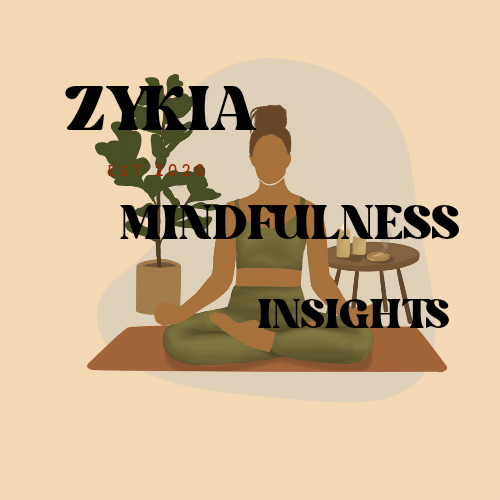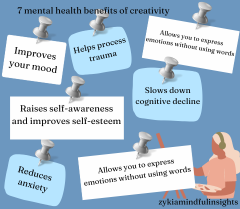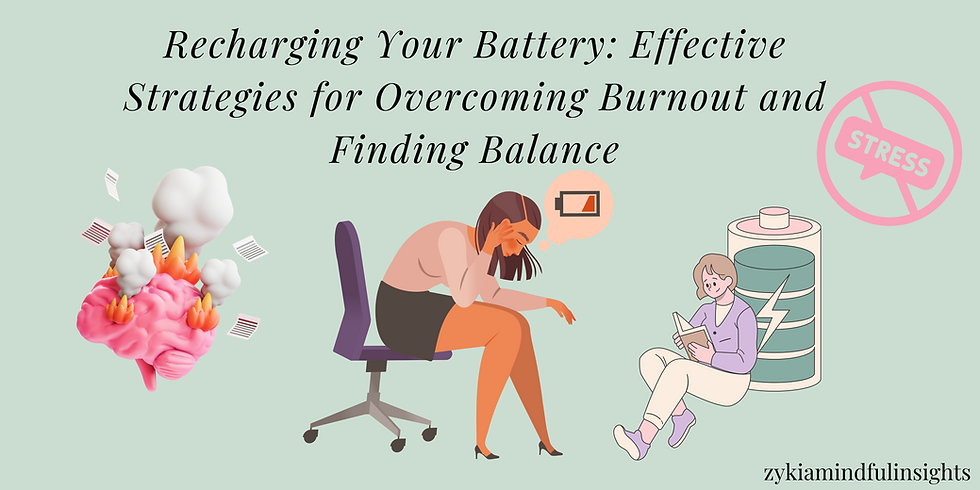Unlocking the Healing Power of Creativity: Exploring Expressive Arts Therapy in Mental Well-being
- Zykia Hannah

- Feb 28, 2024
- 5 min read
Expressive arts therapy is a form of psychotherapy that involves the use of various creative arts such as visual arts, dance, music, drama, and writing to help individuals explore their emotions, improve self-awareness, and develop coping skills. This therapeutic approach is based on the belief that engaging in creative activities can promote mental well-being and personal growth.

The role of creativity in mental well-being is multifaceted. Here are some ways in which expressive arts therapy can contribute to mental well-being:
Self-expression: Creativity provides a safe and non-verbal way for individuals to express their emotions, thoughts, and experiences. This can be especially beneficial for individuals who find it difficult to verbalize their feelings.
Stress relief: Engaging in creative activities can help reduce stress and anxiety by providing a distraction from daily worries and allowing individuals to focus on the present moment.
Emotional regulation: Creative expression can help individuals process and regulate their emotions by providing an outlet for self-expression and self-reflection.
Self-esteem and self-confidence: Through the process of creating art, individuals can gain a sense of accomplishment and mastery, which can boost their self-esteem and self-confidence.
Social connection: Participating in group art activities can foster a sense of belonging and social connection, which are important for mental well-being.
Coping skills: Creative expression can help individuals develop coping skills and resilience, enabling them to better navigate life's challenges.
Overall, expressive arts therapy can play a valuable role in promoting mental well-being by providing individuals with a creative and holistic approach to self-expression and self-exploration.
"Creativity in expressive arts therapy is the brush that paints the canvas of mental well-being, offering a transformative journey of self-expression, healing, and growth."
Expressive arts therapy is an innovative and holistic approach to promoting mental well-being that harnesses the power of creativity as a therapeutic tool. By encouraging individuals to engage in various forms of creative expression, such as painting, drawing, music, dance, and writing, this form of therapy aims to enhance self-awareness, self-expression, and emotional regulation. In the context of mental health, creativity plays a multifaceted role, serving as a means of communication, self-exploration, and coping.
Firstly, creativity serves as a powerful tool for communication, especially for individuals who may struggle to express themselves verbally. Through artistic expression, individuals can communicate complex emotions, thoughts, and experiences in a way that transcends language barriers. This can be particularly beneficial for individuals with conditions such as autism spectrum disorder, where verbal communication may be challenging.
Secondly, creativity enables individuals to explore and make sense of their internal experiences. By engaging in creative activities, individuals can externalize their thoughts and feelings, gaining insight into their emotions and the underlying factors contributing to their mental health challenges. This process of self-exploration can be empowering and contribute to a greater sense of self-awareness and self-understanding.
Thirdly, creative expression can serve as a form of catharsis, providing individuals with a healthy outlet for releasing pent-up emotions and stress. For example, painting or drawing can allow individuals to visually represent their feelings and experiences, while music or dance can provide a physical and emotional release. This cathartic process can promote emotional regulation and help individuals cope with difficult emotions.
Fourthly, creativity can foster a sense of accomplishment and mastery, which is essential for building self-esteem and self-confidence. As individuals engage in creative activities, they can experience a sense of achievement as they create something meaningful and valuable. This can boost their confidence and self-worth, contributing to their overall mental well-being.
Lastly, creativity can facilitate social connection and support, which are crucial for mental health. Participating in group art activities or creative workshops can provide individuals with opportunities to connect with others who share similar experiences and interests. This sense of belonging and community can offer emotional support and a sense of camaraderie, which can be invaluable for individuals struggling with mental health challenges.
In summary, creativity plays a multifaceted role in mental well-being, as demonstrated by the expressive arts therapy approach. By harnessing the power of creativity, this form of therapy enables individuals to communicate, explore, and cope with their internal experiences, leading to greater self-awareness, self-expression, and emotional regulation. Moreover, creativity can contribute to a sense of accomplishment, self-esteem, and social connection, all of which are essential for promoting mental well-being.

Non-judgmental Approach: One key aspect of expressive arts therapy is its non-judgmental approach. It encourages individuals to engage in creative expression without worrying about the outcome. This can be particularly beneficial for individuals who struggle with perfectionism or who are hesitant to engage in creative activities due to fear of criticism.
Mindfulness and Flow: Engaging in creative activities often involves a state of mindfulness, where individuals focus fully on the present moment and the creative process. This state of flow, characterized by intense concentration and enjoyment, can be highly therapeutic and promote mental well-being.
Integration of Mind, Body, and Emotions: The expressive arts therapy approach recognizes the interconnectedness of the mind, body, and emotions. By engaging in creative activities that involve movement (e.g., dance), individuals can experience a holistic form of healing that addresses their physical, emotional, and psychological needs.
Narrative Building and Self-Identity: Creative expression allows individuals to construct and explore their personal narratives, which can contribute to a sense of self-identity and coherence. For example, creating a visual art piece or writing a personal story can help individuals make sense of their life experiences and develop a stronger sense of self.
Resilience and Coping Skills: Engaging in creative activities can help individuals build resilience and develop coping skills that they can apply to various life challenges. For example, using creative expression to process difficult emotions can equip individuals with effective coping mechanisms that they can use in other areas of their lives.
Accessing Unconscious Material: Creativity can serve as a gateway to accessing unconscious material, such as repressed emotions or traumatic memories. By engaging in creative activities, individuals can tap into their unconscious mind and bring hidden thoughts and feelings into conscious awareness, which can be transformative for their mental well-being.
"Expressive arts therapy harnesses the healing power of creativity, providing a nurturing space for self-discovery, resilience, and mental well-being to flourish."
Overall, expressive arts therapy offers a unique and effective approach to promoting mental well-being by harnessing the transformative power of creativity. Through creative expression, individuals can access deeper aspects of themselves, develop coping skills, and experience a greater sense of self-awareness and emotional regulation. This holistic approach to therapy recognizes the interconnectedness of the mind, body, and emotions and offers a safe and supportive environment for individuals to explore and heal.
🩷Quote of the day:
"Start your day with Happiness and Gratitude."🫧




Comments